According to Gallup, employees who have had fantastic onboarding experiences are 2.6 times more likely to be delighted with their jobs and are much more likely to stay with your company.
Not surprisingly, a flawed or insufficient onboarding process is bad for your business. New hires are twice as likely to look for a new job if they don’t enjoy onboarding, and each of those resignation letters costs your company between 50% and 200% of the employee’s salary.
Onboarding matters. A lot. When putting together your onboarding process, the choices you make will impact employee retention, learning, performance, and—by extension—your company’s bottom line. That's why we put together this end-to-end guide for onboarding. In it, we map out everything you need to make an excellent first impression and convert new hires into valuable, long-lasting team members.
Not ready to dive into our onboarding guide right now? No problem! Download our playbook:
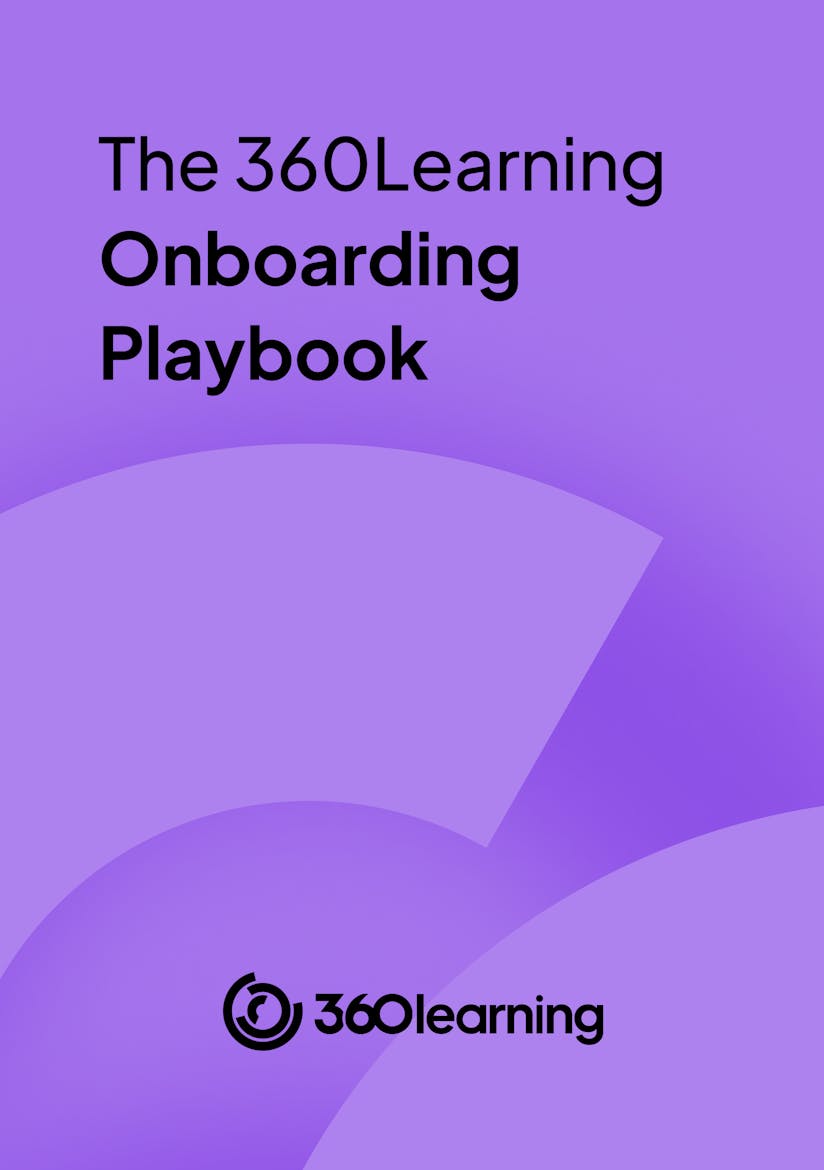
The Onboarding Playbook we swear by
By providing your contact info, you agree to receive communications from 360Learning. You can opt-out at any time. For details, refer to our Privacy Policy.
New hires are twice as likely to look for a new job if they have a poor onboarding experience.
What's the purpose of onboarding employees?
Employee onboarding is how you introduce a new hire to your organization—through a series of standardized events and milestones. Onboarding should help new employees learn about their new company, their co-workers, and their individual roles and responsibilities.
Onboarding differs from employee orientation because it takes place over weeks or months instead of being a one-time event. While onboarding also gives new hires basic information about the company, such as security badges and employee handbooks, it extends from the moment an employee signs their contract until several months into their new job, giving them the skills they need to succeed in their new role.
Onboarding is often conducted by human resources or by the learning and development team. A well-defined and organized onboarding process is essential for helping new employees feel confident both in their role and at the company.
5 benefits of an effective onboarding process
The impact of onboarding—positive or negative—affects an employee’s entire time at your company. When you invest in creating a positive and valuable onboarding experience, new hires will appreciate it, and the company will be better off.
1. Onboarding bolsters early retention
Employees want you to invest in their career development. Without enough support, new hires start off their job with doubt and distrust, driving 20% of them to quit within their first 45 days. If you don’t give them chances to grow, they’re increasingly willing to quit—even if they don’t have another job lined up.
Onboarding is your first (and biggest) opportunity to demonstrate you’re invested in employee growth. When you create an effective onboarding process, you’ll help new hires acclimate to the day-to-day and demonstrate your employee value proposition by investing in their growth from the start.
2. Onboarding helps employees zip through dull tasks
Strong onboarding processes combine organization and tech to get through new-hire admin tasks quickly (and without boring them to tears). Starting a job is, by nature, an admin-heavy process. The average onboarding program has more than 50 tasks for the new employee, including setting up company accounts, filling out tax documents, signing forms, and getting on the payroll. Paperwork is a buzzkill, and without an efficient process in place, it can stifle the momentum a new hire has coming into the job.
3. Onboarding fast-tracks productivity
Your employees need a high-learning, low-stakes period to acquire skills and become familiar with your tools and processes, and onboarding is the perfect time to do it. When you hire someone with great potential, they want to contribute right away, but they need guidance on how your company works. Onboarding helps get them up to speed quickly, so they can start contributing as soon as possible.
4. Onboarding builds trust and community
Onboarding is a pivotal moment for community building and welcoming new people into your existing community. It's also a fantastic opportunity to set the tone of your company culture and make sure everyone feels like they're part of a team. Ideally, new hires will plant the seeds for professionally and personally meaningful relationships during onboarding. Otherwise, they may feel isolated and build walls that keep them from being a happy or productive member of the team.
“Our understanding of what leads to professional satisfaction is often misplaced. People tend to overestimate the importance of the what when they should be focusing on the who.” — Rob Cross, coauthor of The Hidden Power of Social Networks
5. Onboarding strengthens company culture
If we had to name the single most important goal of onboarding, we’d point to its ability to introduce your new hires to your company culture.
If your onboarding program helps new hires feel like they’re a part of your company’s team, everything else will fall into place much, much easier. At 360Learning, for example, our culture is built around collaborative learning. If we get new hires on board with our culture of collaborative learning, future challenges are much easier to tackle because we’ve established a precedent of accountability and peer-based learning.
How to create an extraordinary onboarding plan
It's important to create an onboarding process that makes new hires feel welcome and valued from day one. When employees feel like they're being welcomed into something special, they'll be more likely to stick around long term. 94% of people say they would stay at a company if it gave them opportunities to learn—onboarding provides learning opportunities right away.
So how can you create a top-notch onboarding program? We’re so glad you asked.
Get off to a good start with preboarding
If you’re waiting for an employee’s first day to kick off onboarding, you’re already behind. Preboarding is a great time to get an incoming hire excited about your new relationship. They’re probably nervous about their first day and stressing about the small stuff. Consider this period as an opportunity to get on their good side before they step foot in the office (or log on to the server) for the first time.
By following these nine steps, you’ll create a winning preboarding experience:
- Send a welcome package. Include a healthy mix of helpful and just-for-fun items. Salesforce’s experience and design new hires get a personalized welcome kit that includes items like field notes, a mug, a shirt, and a gift certificate for a new pair of headphones to brighten up their workspace.
- Collect feedback about recruitment and hiring. With every new hire, provide an avenue for anonymous feedback, like surveys or forms. It’s important to be ready to receive insight from new hires and act on it.
- Chip away at admin to-dos. Some paperwork can be started or even completed before the first day. This includes things like the employment contract, tax forms, etc.
- Share FAQs and other important info. Over time, you might notice people stress about the same things. Fight first-day nerves by providing information about minor details like parking, Slack etiquette, and dress code. But keep it manageable. You don't want to overwhelm a newbie with too much info, especially if they won't need it on the first day.
- Send onboarding calendar invites. This helps new hires prepare both mentally and logistically for meetings, training sessions, walk-throughs, and other necessary appointments. For example, if you're expecting your new hire to attend a meeting with your HR manager, provide an invite and include any details that might help them prepare. You can also tell them they'll receive a flood of invites they can simply accept and sort through later.
- Host an informal get-together. Onboarding doesn’t have to be all business—we’re building culture here, too! Host a virtual team happy hour, and kick it off with icebreakers to keep things casual.
- Invite new hires to explore your learning platform. Send over the login credentials, so they can start clicking around and getting used to the interface of the platform.
- Ask them to make a personalized introduction. Encourage them to make an authentic introduction! Use video or get-to-know-you surveys to make connections more personal and genuine and help with team building.
- Loop in the whole team to prep a great welcome. A warm welcome is a family affair. Let the whole team know when to expect the new hire, so they can be ready with open arms.
Read more:
The first day of onboarding (orientation)
If preboarding is like swiping right, the employee's start day is the first date. It’s an opportunity for you and your new hire to really get to know one another and prove you don’t have smelly breath. More importantly, it sets the foundation for (hopefully) a long-term relationship.
- Give them the lay of the land. They won’t be experts after one day, but a basic level of comfort getting around their work environment, whether that’s in an office or virtually, will go a long way.
- Introduce them to key colleagues. Otherwise, they might spend days awkwardly bumping into them without ever officially saying “hello”; don’t forget the onboarding buddy—a current employee assigned to help a new hire adjust.
- Complete day-one courses. Introductory materials or meetings often include company values, company organization, and other high-level information.
- Offer quick-start tutorials. Give new hires self-serve ways to learn how to use company tools and access your knowledge base. During the first few days, new hires will want to do some digging in their spare time; you might as well give them a goldmine of company knowledge.
- Don’t forget to celebrate! A warm, enthusiastic welcome can do wonders for first-day nerves.
The first week of onboarding
Congrats! You made it past the first date. Next, you and the new hire will start getting used to seeing one another on the regular. It’s important to hold their interest, but don’t be too clingy.
- Offer role-specific training. Once the new team member finishes their initial onboarding courses, move from general information to more role-specific training.
- Plan discovery meetings. Discovery meetings introduce new hires to different departments and are a great way to build a wider community and give them a big-picture look at the entire organization.
- Practice asynchronous learning. Don’t drag your new hire into a classroom or meeting for every piece of information; let them work through defined learning tracks at their own pace.
- Schedule informal daily check-ins. Nobody wants a helicopter boss, but you don’t want to check in on Friday only to find out they’ve been stuck on creating a password since Monday.
The first month of onboarding
During the first month, you and the new hire will wrap up the get-to-know-you phase and start going steady. You may not have said the L-word yet, but that’s completely normal.
- Close skills gaps. Collaborative learning helps you reveal institutional knowledge, which gives new employees insight into how company veterans do their jobs.
- Set personal OKRs. New hires should meet with their manager to establish long-term OKRs (objectives and key results) and put a plan in place to make steady progress.
- Switch to weekly check-ins. Each week, managers and onboarding buddies should check in with new employees to ensure they’re feeling comfortable, confident, and supported.
- Give them more responsibility. The first month is when new hires stop asking, “how do I do this?” and start asking, “how do I do this well?” Give them new responsibilities accordingly.
The first three months of onboarding
After 90 days of onboarding, you’ve successfully cleared the new-relationship hurdle. You’re not quite married, per se. In fact, your chances of tying the knot—long-term employee retention—increase if strong onboarding practices continue throughout the new hire’s first year. However, after three months of strong onboarding, you’ve built a foundation for a healthy, long-lasting relationship.
- Measure role mastery. Using a skills assessment, progress on a learning platform, or some other evaluation, hold a formal review of the new hire’s abilities.
- Hold monthly 1:1s. Throughout the first three months, the onboarder should fade away as the manager begins checking in with the new hire more regularly.
- Schedule a six-week probation review. If your company has a probation policy, 45 days is a fair period to suspend a full-time offer.
- Add social events with the team. Who doesn’t love an offsite team lunch or happy hour? Plus, it’s a great way to facilitate team bonding.
Read more:
Advanced tips: 6 guiding principles of onboarding
The nitty-gritty details of onboarding will look different for each company, but these high-level strategies are sure to elevate any onboarding program.
1. Keep scaling in mind
Scalable onboarding is repeatable, resistant to human error, and resilient to unknown changes. Plus, done right, onboarding naturally grows alongside your company.
Here's how we recommend managing onboarding for a growing company:
- Appoint onboarding facilitators. As effective as technology is, nothing replaces the human touch. Whether it’s a dedicated L&D team, a fellow onboarder, or an onboarding buddy, you need facilitators who can offer guidance and support when needed.
- Expect the unexpected. No matter how solid your plans are, everything can go haywire at any moment. It’s important to have contingency plans in place.
- Encourage on-the-job learning. According to Emma Schain, former learning and development lead at Better.com, 70% of learning happens when the work is being done. This gives new hires hands-on experience and a level of comfort that training alone can’t match.
2. Leave room for feedback and adjustments
A solid onboarding program requires a lot of planning, but you’ll need to add some wiggle room to account for any adjustments you might need to make.
A sense of discovery goes a long way, and your teams will appreciate having some control over their onboarding experience. In the spirit of collaboration, encourage your new hires to:
- complete learning modules asynchronously (when their workday allows)
- participate in peer-based training
- express concerns or questions when onboarding doesn’t make sense
- share feedback about their onboarding experience
- request new learning materials
3. Personalize onboarding for every new hire
Picture this: you show up for your first day of work and a dense instruction manual is sitting on your desk. There’s a sticky note that says, “Here’s how to do the job. Finish this in 90 days.” That sinking feeling in your gut is exactly why personalized onboarding is so important.
Onboarding shouldn’t be one-size-fits-all. Personalization drives greater retention of learning material because learners are more authentically engaged when the content is specific to them and their role within the company. Don’t forget that actual people will be living through your onboarding program.
4. Communicate at every step
Like a new relationship, great onboarding depends on honest, consistent communication. Establishing a healthy cadence of communication with new hires is key to building lasting trust, boosting employee engagement and performance, creating an effective feedback loop, and keeping employees on track.
At 360Learning, we’re staunch advocates of the idea that not everything needs to be a meeting. Instead, we use asynchronous communication whenever possible to ensure communication is lean, direct, and doesn’t clog everyone’s calendars.
5. Mix it up
It’s important to keep your new hires interested and engaged. Make sure your onboarding program contains a healthy balance of different types of learning methods.
Here’s how 360Learning mixes things up to keep onboarding interesting:
- A collaborative learning platform turns regular training and onboarding into a hearty, asynchronous exchange of peer knowledge.
- On-the-job training gives new hires a chance to put their learning to the test in the actual context of the job.
- One-on-one meetings with managers can realign new hires with personal, team, and company goals, making them more motivated and productive.
6. Measure, optimize, repeat
Monitoring the results of your program will confirm you're properly preparing new hires for their roles. Here are two effective ways to measure the effectiveness of your new employee onboarding process:
Assessments and quizzes help you find out if you’ve met your learning objectives. You’ll use these tactics to check comprehension at the end of the lessons.
Surveys and feedback shed light on the employee experience and satisfaction. This process will provide you with the qualitative data you need to make a business case for onboarding and future L&D programs.
At 360Learning, we use both to gauge how well our onboarding prepares new hires for the job. New hires even take a short course on employee feedback to understand why and how it’s done at our organization.
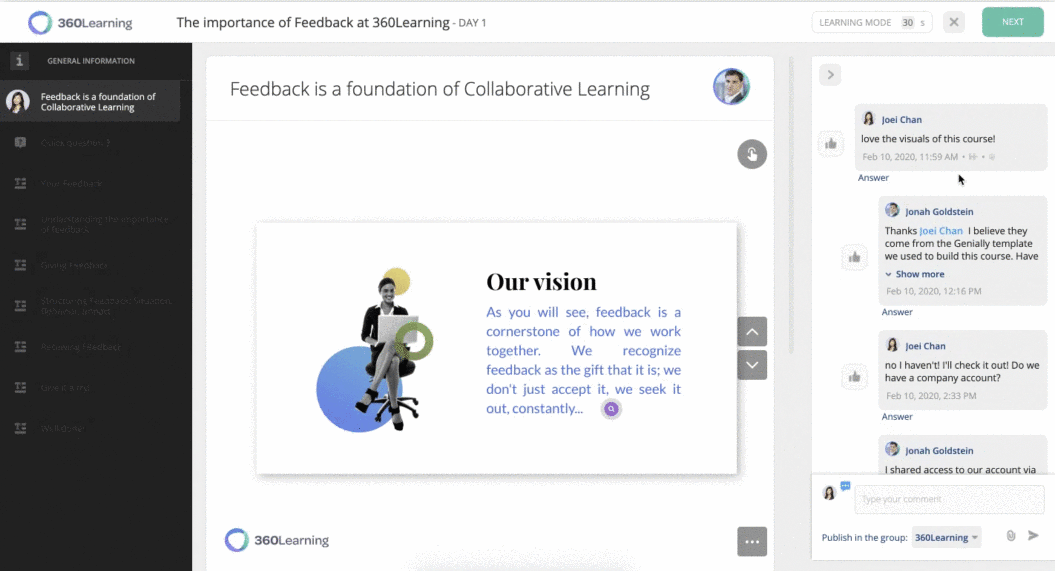
3 tips for remote onboarding
Due to technological advances and an unexpected global crisis, many companies have transformed into digital-first workplaces. Fortunately, innovations in digital tools make it possible to cultivate a great onboarding experience for your remote employees.
As a general rule, you can employ the same strategies and roadmaps for virtual onboarding that you use for in-person offices. However, remote onboarding might require some additional tools and tactics. Use these tips to ensure remote onboarding achieves all the same benefits as the in-person alternative.
Embrace digital collaboration
Even in a digital environment, collaboration is key. Without face-to-face contact, new hires need extra support to learn from, work alongside, and bond with co-workers.
Virtual meeting software like Zoom and Google Hangouts are great for distributed teams, but you can have too much of a good thing. We wholeheartedly recommend an asynchronous-first model to foster collaboration without all the Zoom fatigue and wasted time. For less formal meetings, try a tool like Around that lets you play games and host campfire discussions.
Asynchronous communication and productivity tools like Trello and Asana and a learning platform like 360Learning can help you bring new hires into the huddle without demanding hours of unnecessary virtual meetings.
Check in and reach out often
Starting a new job behind a computer screen can make you feel invisible. You never meet your colleagues face-to-face, have spontaneous check-ins in the hall, or get a reassuring wave from your manager when you arrive at the office. As a result, new remote employees can feel out of the loop, unsure of how to spend their time, and afraid to ask for clarification.
Go the extra mile to personalize your outreach and provide as much clarity as possible. At 360Learning, for example, we use Trello to give each new hire specific course recommendations, goals, and checkpoints. This helps new hires stay on track and provides that extra sense of security that they’re not missing something.
Here’s a quick, personalized nudge you might see during remote onboarding:
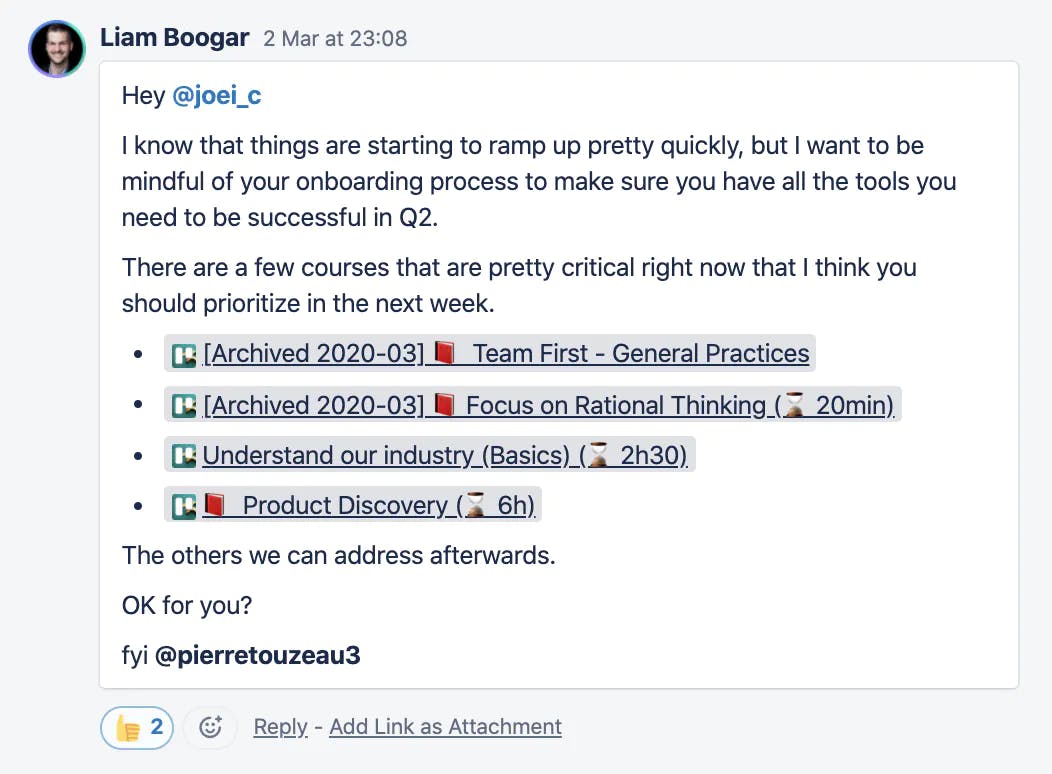
Establish clear metrics
Another way to help new hires stay on track—a particular challenge if you’re not sitting in the same office—is to give employees a roadmap for success.
At 360Learning, we ask employees to set quarterly OKRs, and we also include knowledge and satisfaction checks in our onboarding courses. We want to make sure each training session has a clear payoff and that the new hire walks away with a solid understanding of why they just spent time taking the course.
Employees can earn badges and high scores and track their progress over the course of onboarding.
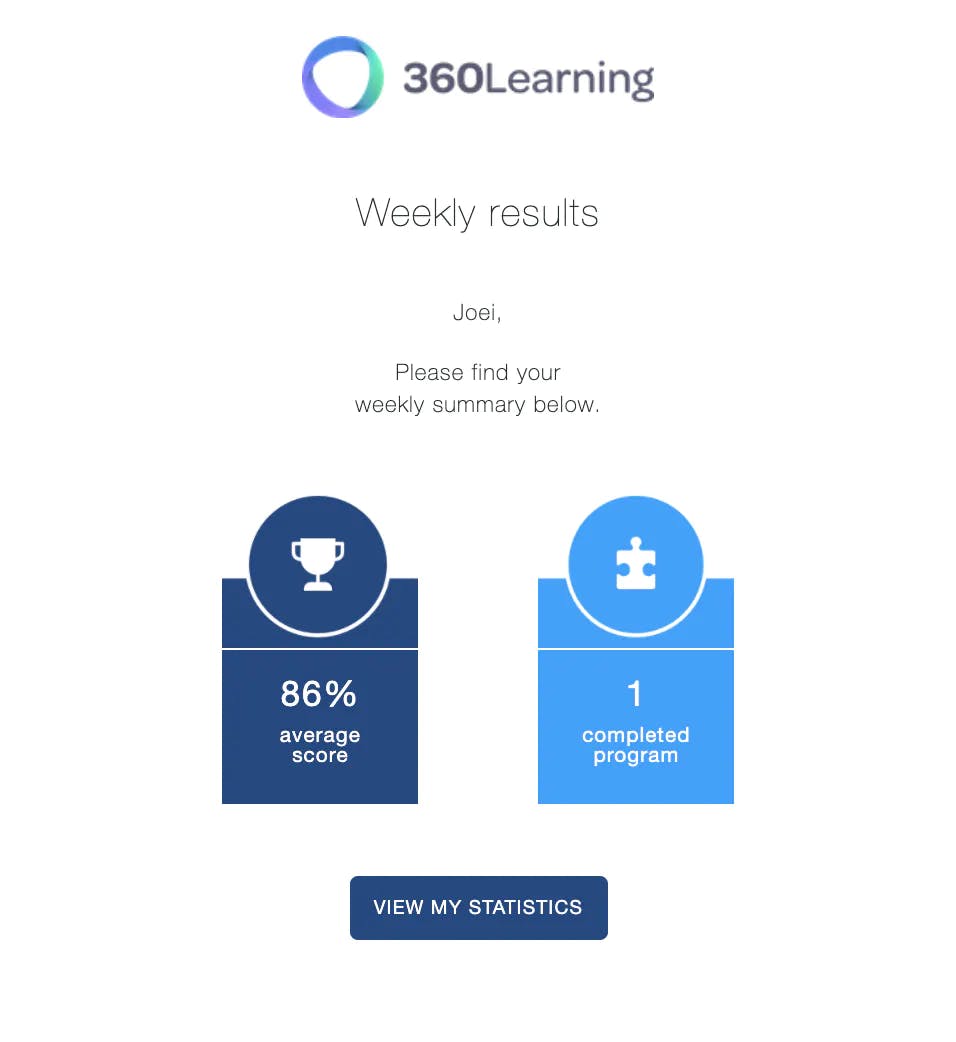
Also, we collect feedback from employees to ensure the training is clear, interesting, and up to date. The learner can also leave public questions and comments for the course author, improving the course for future learners.
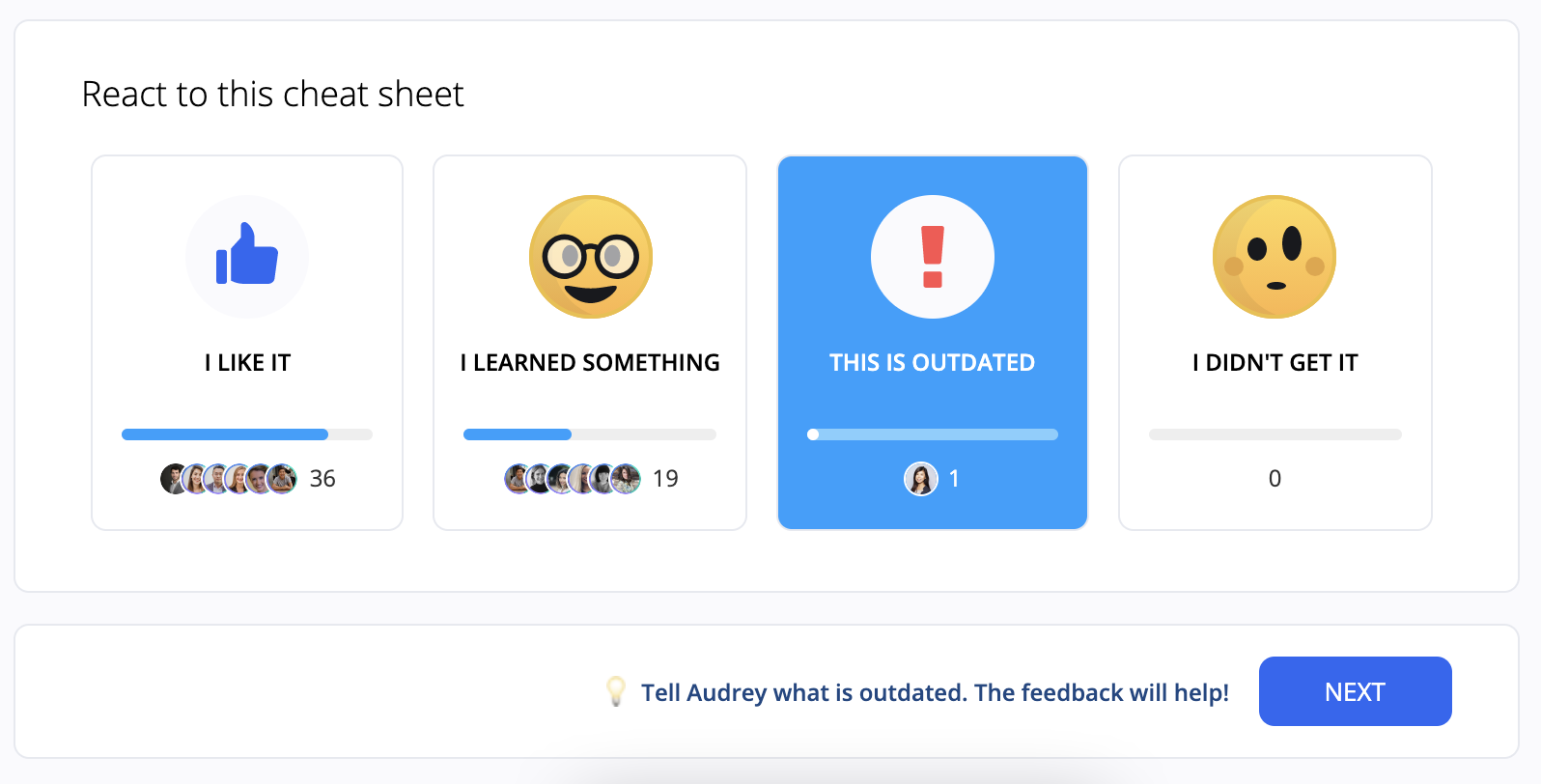
Use your onboarding process to create a culture of learning
By the end of your employee onboarding, don’t expect your new hires to be married to your company—that’s not the point. The point is to get new hires comfortable with teamwork and collaboration so that learning doesn’t stop after 90 days. For example, one of the best markers of a successful onboarding program is when a new hire looks for help. Ideally, before too long, new hires stop turning to their onboarder or manager for help. Instead, they start consulting the company’s learning resources and their peers to overcome challenges.
To achieve this at 360Learning, we built our company around the principles of peer-based collaborative learning. We do our best work with decentralized, peer-driven, and accountable processes. The way we see it, as long as our employees have the tools and motivation to continually grow, the only place we can go is up.
Want to launch an onboarding program that works in 2025 and beyond? Download The Onboarding Playbook we swear by.


